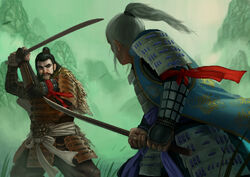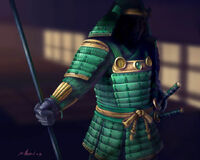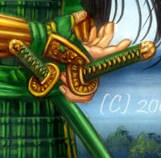
The Emerald Champion
The Emerald Champion was the leader of the Emerald Magistrates and was responsible for the protection of the Emperor himself.
Test of the Emerald Champion

Emerald Championship contenders
Upon a vacancy in the post of Emerald Champion, the successor was decided by means of a tournament, to which samurai of all the clans were invited. The rules of this tournament where in flux during the first centuries. The third Test, held in 79 was the first to be structured as a formal iajutsu competition, and the fourth (108) was the first to incorporate tests of etiquete, strategy and martial ability. [1]
While Kakita was traditionally considered to be the first Emerald Champion when he defeated Matsu, [2] the post wasn't created until 153, with Doji Hatsuo the first official holder of the mantle. [3]
Emerald Champion Estates
For a thousand years the land north and to the west of Otosan Uchi belonged to the Emerald Champion. The castle itself, the Palace of the Emerald Champion, sat on a high hill surrounded by a wide empty plain, the Plains of the Emerald Champion. The Imperial Chrysanthemum was proudly displayed at the castle's front gate. [4] After the Fall of Otosan Uchi the Emerald Champion was housed in a Estate in Toshi Ranbo, [5] within the Castle of Law. [6]
Succession

When the post of Emerald Champion became vacant upon the retirement or death of the previous Champion, a grand tournament was held to select the new Champion. The tournament was generally the same format as many others throughout Rokugan. First, the claimants to the position were given several written and verbal tests to ensure they had the legal knowledge necessary to be appointed the Chief Magistrate of the Empire. After that, a series of iaijutsu duels determined who was most fit to serve as the Emperor's Champion. The Emperor himself presided over the tournament. The new Emerald Champion was not severed from his clan and retained his original family name. [7] [8] [9]
Sometimes, if the Emperor was indisposed, the tournament could be called in his name. This happened when Bayushi Kachiko did so during the Clan War, resulting in Kakita Toshimoko becoming champion.[10] In cases of there being no Emperor because of an unclear line of succession, the Heirs could call for the tournament. the Four Winds, heirs of Toturi I did so, resulting in Yasuki Hachi becoming champion. The Daimyo of the Imperial Families could also do this, as shown by Otomo Hoketuhime and the tournament which resulted in Shosuro Jimen becoming champion. [11]
The First Chosen Champion

Seppun Toshiken became the first (and to date only) Emerald Champion to be chosen directly by the Emperor Toturi I in 1132. [12] Shortly before his death, Emperor Toturi decided that a tournament should again decide who will succeed the ailing Seppun Toshiken as Emerald Champion, and ordered his son Hantei Naseru to begin with the preparations. The tournament took place even though the Emperor had died without a clear successor, and was won by Yasuki Hachi. [13]
It should be noted that although Toshiken was the first Emerald Champion to be chosen directly, past Emperors have directly appointed Emerald Champions temporarily. The most notable example of this during the reign of Hantei III, when Emerald Champion Doji Kuzume refused to execute Togashi Kaze and committed seppuku. After Kuzume's death, the Emperor temporarily elevated Lion Clan Champion Matsu Noshin to the position and ordered him to execute Kaze, which he did. [14]
During the War Against the Shadow, another sucession crisis occured when Emerald Champion Kakita Toshimoko faked his death and disappeared, leaving the Emerald Magistrates without a leader. In Emperor Toturi's absence, a new tournament could not be called, so Shinjo Shirasu, himself a high-ranking Emerald Magistrate, took over as their leader for two years until Toturi's rescue. Shirasu, however, did not use the title of Emerald Champion. [15]
Duties
Imperial Bureaucracy
The Emerald Champion oversaw the Ministry of Territories and the Ministry of Martial Levies, which belonged to the Imperial Bureaucracy. [16]
Imperial Legions
The Imperial Legions were usually commanded by the Emerald Champion, but after the death of Iuchiban in 1166 the Emerald Magistrates continued to enforce the Emperor's laws, but the Imperial Legions followed the orders of the Shogun Kaneka. [17]
Defense of the Imperial City
The Lion standing army of the Enchanted Wall was under the command of the Emerald Champion, [18] but this duty was most probably passed to the Protector of the Imperial City when the post was occupied. [19]
Periodically reported
Four times a year the Emerald Champion made a journey to get report of the many Magistrates appointed all around the Empire. The trip began at the Imperial City, and moved to Mamoru Kyotei Toshi, Kyuden Ikoma, and Kosaten Shiro. [20]
Spies
The Emerald Champion also used spies to fullfill his duties. They were called Metsuke. [21]
Duties reduced

In 1170 the duties of the Emerald Champion were reduced. The Imperial Treasurer post was created by the Empress Iweko I to oversee the collection of the Imperial taxes. the Emerald Champion remained with the mission of adjudicate the laws of the Empire. [22]
Minor Emerald Championships
The Divine Empress Iweko I ordered the Emerald Champion to hold his tournament on an annual basis, not to replace the Champion, but to give the samurai of the Empire an outlet for their competitive natures, and to provide opportunities for advancement. Each year would hold a tournament of the sort normally used to fill the position, and the winner of these tournaments would become favored vassal of the Emerald Champion. [23]
Mon
A laurel wreath was the mon of the Emerald Champion. [24]
Emerald Champions of Rokugan
| Kakita | 23 - 46 |
| Kakita Shimizu | 48 - 79 |
| Doji Sasumagi | 79 - 108 |
| Akodo Saito | 108 - (c. 150) |
| Doji Hatsuo | 150 - 183 (first official champion) |
| Doji Kuzume | ? - 268 |
| Matsu Noshin | 268 - ? |
| Crane samurai-ko [25] | 4th century |
| Doji Raigu | 389 - 435 |
| Doji Usan | 435 - 436 |
| Vacant | 436 - 438 |
| Matsu Mochiko, formerly Matsu Mochihime | 438 - (c. 442) |
| Doji Shioden | (c. 501) |
| Daidoji Yayoi | (c. 510) |
| Doji Komatsu | ? - ? (c. 6th century) |
| Doji Kukojin | ? - ? (c. 6th century) |
| Doji Rin | ? - 591 |
| Masamune | 7th century |
| Akodo Kenburo | (c. 660) - 684 |
| Doji Daisetsu | (c. 750) |
| Doji Ryobu | 811 - ? |
| Doji Tsukihi | (c. 1109) |
| Doji Satsume | ? - 1123 |
| Ide Makujin (acting champion) | 1123 - (c. 1125) |
| Kakita Toshimoko | 1127 - 1130 |
| Shinjo Shirasu (acting champion) | 1130 - 1132 |
| Seppun Toshiken | 1132 - 1158 |
| Yasuki Hachi | 1158 - 1168 |
| Shosuro Jimen | 1169 - 1173 |
| Utaku Ji-Yun | 1198 - 1199 |
| Mirumoto Tsuda | 1199 - Present |
Known Technique
- The Emperor's Hand
References
- ↑ Imperial Histories 2, p. 34, 36
- ↑ Winter Court: Kyuden Seppun, p. 32
- ↑ Secrets of the Crane, p. 8
- ↑ Legend of the Five Rings; First Edition, p. 238
- ↑ To Defend the Emperor, Part 1, by Shawn Carman
- ↑ Strongholds of the Empire, p. 118
- ↑ Way of the Magistrate, written by Scott Gearin and published in the Imperial Herald
- ↑ Secrets of the Crane, p. 8
- ↑ Four Winds, p. 31
- ↑ Test of the Emerald Champion, Imperial Herald #2
- ↑ Test of the Emerald Champion, Part 1, by Brian Yoon
- ↑ Legend of the Five Rings; Third Edition, p. 22
- ↑ Victorious, A Tale of Rokugan, by Rich Wulf
- ↑ Open Hand, p. 66-67
- ↑ Hidden Emperor, pp. 12-14
- ↑ Secrets of the Empire, p. 119
- ↑ Heavy Infantry (Lotus flavor)
- ↑ Otosan Uchi:Book 2, p. 18
- ↑ Secrets on the Wind - Part 1, by Rich Wulf and Shawn Carman
- ↑ City of Lies: GM's Guide, p. 61
- ↑ Roleplaying in the Emerald Empire, p. 11
- ↑ Imperial Treasurer - Yoritomo Utemaro (The Conclusion, Part 2), by Shawn Carman
- ↑ The Jeweled Champions (Tourneys)
- ↑ Winter Court: Kyuden Seppun, p. 57
- ↑ Fealty and Freedom, p. 8
 |
This Imperial Families related article is a stub. That means that it has been started, but is incomplete. You can help by adding to the information here. |
External Links
- The Emerald Championship (Promotional)
References
 |
This Imperial Families related article is a stub. That means that it has been started, but is incomplete. You can help by adding to the information here. |